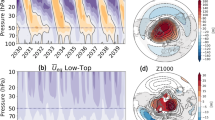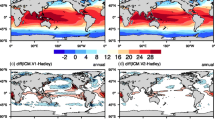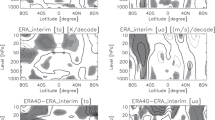Abstract
This study investigates the robustness of the stratospheric pathway in linking the sea ice variability over the Barents-Kara Sea in late autumn and early winter to the mid-latitude circulation in the subsequent winter. Two groups of models from the Coupled Model Intercomparison Project phase 5 (CMIP5) archive, one with a well-resolved stratosphere (high-top models) and the other with a poorly-resolved stratosphere (low-top models) are explored to distinguish the role of the stratospheric pathway. The results show that, collectively, high-top models are able to capture the persistent mid-latitude circulation response in the subsequent winter. The response in low-top models is, however, weaker and not as long-lasting most likely due to lack of stratospheric variability. Analysis of eddy heat flux reveals that stronger vertical wave propagation leads to a stronger response in stratospheric polar vortex in high-top models. In particular, it shows that zonal wave-2 eddy heat flux is crucial in leading to a stronger linear constructive interference with the climatological waves in high-top models. The results find that multi-model ensemble of CMIP5 high-top models is able to capture the prolonged impact of sea ice variability on the mid-latitude circulation and out performs the low-top models in this regard. Our study suggests that the representation of the stratosphere in climate models plays an important role in amplifying and extending the mid-latitude circulation response.






Similar content being viewed by others
References
Bader J, Mesquita MDS, Hodges KI, Keenlyside N, sterhus S, Miles M (2011) A review on northern hemisphere sea–ice, storminess and the North Atlantic oscillation: observations and projected changes. Atmos Res 101:809–834. https://doi.org/10.1016/j.atmosres.2011.04.007
Barnes EA, Screen JA (2015) The impact of Arctic warming on the midlatitude jet-stream: can it? Has it? Will it? Wiley Interdiscip Rev Clim Change 6(3):277–286. https://doi.org/10.1002/wcc.337
Barnes EA, Simpson IR (2017) Seasonal sensitivity of the northern hemisphere jet-streams to Arctic temperatures on subseasonal timescales. J Clim 30(24):10,117–10,137. https://doi.org/10.1175/JCLI-D-17-0299.1
Boland EJD, Bracegirdle TJ, Shuckburgh EF (2017) Assessment of sea ice-atmosphere links in CMIP5 models. Clim Dyn 49:683–702. https://doi.org/10.1007/s00382-016-3367-1
Cai D, Dameris M, Garny H, Runde T (2012) Implications of all season arctic sea–ice anomalies on the stratosphere. Atmos Chem Phys 12:11,819–11,831. https://doi.org/10.5194/acp-12-11819-2012
Cassano EN, Cassano JJ, Higgins ME, Serreze MC (2014) Atmospheric impacts of an arctic sea ice minimum as seen in the community atmosphere model. Int J Climatol 34:766–779. https://doi.org/10.1002/joc.3723
Charlton-Perez AJ, Baldwin MP, Birner T, Black RX, Butler AH, Calvo N, Davis NA, Gerber EP, Gillett N, Hardiman S, Kim J, Krger K, Lee Y, Manzini E, McDaniel BA, Polvani L, Reichler T, Shaw TA, Sigmond M, Son S, Toohey M, Wilcox L, Yoden S, Christiansen B, Lott F, Shindell D, Yukimoto S, Watanabe S (2013) On the lack of stratospheric dynamical variability in low-top versions of the CMIP5 Models. J Geophys Res Atmos 118:2494–2505. https://doi.org/10.1002/jgrd.50125
Charney JG, Drazin PG (1961) Propagation of planetary-scale disturbances from the lower into the upper atmosphere. J of Geophys Res 66:83–109. https://doi.org/10.1029/JZ066i001p00083
Cohen J, Foster J, MBarlow, Saito K, Jones J (2010) Winter 2009–2010: a case study of an extreme Arctic oscillation event. Geophys Res Lett 37(L17):707. https://doi.org/10.1029/2010GL044256
Cohen J, Screen JA, Furtado JC, Barlow M, Whittleston D, Coumou D, Francis J, Dethloff K, Entekhabi D, Overland J, Jones J (2014) Recent Arctic amplification and extreme mid-latitude weather. Nat Geosci 7:627–637. https://doi.org/10.1038/ngeo2234
Collins M et al (2013) Long-term climate change: projections, commitments and irreversibility. Clim Change Phys Sci Basis 1029 –1136
Comiso JC (2000) bootstrap sea ice concentrations from nimbus-7 SMMR and DMSP SSM/I-SSMIS, Version 2, [1979-2013]. Boulder, Colorado USA NASA DAAC at the National Snow and Ice Data p https://doi.org/10.5067/J6JQLS9EJ5HU
Dee DP, Coauthors (2011) The ERA-interim reanalysis: configuration and performance of the data assimilation system. QJR Meteorol Soc 137:553–597. https://doi.org/10.1002/qj.828
Deser C, Tomas RA, Sun L (2015) The role of oceanatmosphere coupling in the zonal-mean atmospheric response to arctic sea ice loss. J Clim 28:2168–2186. https://doi.org/10.1175/JCLI-D-14-00325.1
Deser C, Sun L, Tomas RA, Screen J (2016) Does ocean coupling matter for the Northern extratropical response to projected Arctic sea ice loss? Geophys Res Lett 43:2149–2157. https://doi.org/10.1002/2016GL067792
Furtado JC, Cohen JL, Butler AH, Riddle EE, Kumar A (2015) Eurasian snow cover variability and links to winter climate in the CMIP5 models. Clim Dyn 45:2591–2605
Garfinkel CI, Hartmann DL, Sassi F (2010) Tropospheric precursors of anomalous northern hemisphere stratospheric polar vortices. J Clim 23:3282–3299. https://doi.org/10.1175/2010JCLI3010.1
Garfinkel CI, Shaw TA, Hartmann DL, Waugh DW (2012) Does the Holton tan mechanism explain how the Quasi-Biennial oscillation modulates the Arctic polar vortex? J Atmos Sci 69:1713–1733. https://doi.org/10.1175/JAS-D-11-0209.1
Gong T, Feldstein S, Lee S (2017) The role of downward infrared radiation in the recent Arctic winter warming trend. J Clim pp 4937–4949. https://doi.org/10.1175/JCLI-D-16-0180.1
Hoshi K, Ukita J, Honda M, Iwamoto K, Nakamura T, Yamazaki K, Dethloff K, Jaiser R, Handorf D (2017) Poleward Eddy heat flux anomalies associated with recent Arctic sea ice loss. Geophys Res Lett 44:446–454. https://doi.org/10.1002/2016GL071893
Jaiser R, Dethloff K, Handor D (2013) Stratospheric response to Arctic sea ice retreat and associated planetary wave propagation changes. Tellus 65A(19):375. https://doi.org/10.3402/tellusa.v65i0.19375
Kelleher M, Screen J (2018) Atmospheric precursors of and response to anomalous Arctic sea ice in CMIP5 models. Adv Atmos Sci 35:27–37. https://doi.org/10.1007/s00376-017-7039-9
Kidston J, Gerber E (2010) Intermodel variability of the poleward shift of the Austral Jet stream in the CMIP3 integrations linked to biases in 20th century climatology. Geophys Res Lett 37(L09):708. https://doi.org/10.1029/2010GL042873
Kim BM, Son SW, Min SK, Jeong JH, Kim SJ, Zhang X, Shim T, Yoon JH (2014) Weakening of the stratospheric polar vortex by Arctic sea ice loss. Nat Commun 5:4646. https://doi.org/10.1038/ncomms5646
Kretschmer M, Coumou D, Donges JF, Runge J (2016) Using causal effect networks to analyze different Arctic drivers of midlatitude winter circulation. J Clim 29:4069–4081. https://doi.org/10.1175/JCLI-D-15-0654.1
Kug JS, Jeong JH, Jang YS, Kim BM, Folland CK, Min SK, Son SW (2015) Two distinct influences of arctic warming on cold winters over North America and East Asia. Nat Geosci 8:759–762. https://doi.org/10.1038/ngeo2517
Lu J, Cai M (2009) Seasonality of polar surface warming amplification in climate simulations. Geophys Res Lett 36(L16):704. https://doi.org/10.1029/2009GL040133
Manzini E, Karpechko AY, Anstey J, Baldwin MP, Black RX, Cagnazzo C, Calvo N, Charlton-Perez A, Christiansen B, Davini P, Gerber E, Giorgetta M, Gray L, Hardiman SC, Lee YY, Marsh DR, McDaniel BA, Purich A, Scaife AA, Shindell D, Son SW, Watanabe S, Zappa G (2014) Northern winter climate change: assessment of uncertainty in CMIP5 projections related to stratosphere-troposphere coupling. J Geophys Res Atmos 119:7979–7998. https://doi.org/10.1002/2013JD021403
McCusker KE, Fyfe JC, MS M (2016) Twenty-five winters of unexpected Eurasian cooling unlikely due to Arctic sea–ice loss. Nat Geosci 9:838–842. https://doi.org/10.1038/ngeo2820
McGraw M, Barnes EA (2018) Memory matters: a case for granger causality in climate variability studies. J Clim. https://doi.org/10.1175/JCLI-D-17-0334.1
Mori M, Watanabe M, Shiogama H, Inoue J, Kimoto M (2014) Robust arctic sea–ice influence on the frequent eurasian cold winters in past decades. Nat Geosci 7:869–873. https://doi.org/10.1038/ngeo2277
Nakamura T, Yamazaki K, Iwamoto K, Honda M, Miyoshi Y, Ogawa Y, Tomikawa Y, Ukita J (2016) The stratospheric pathway for Arctic impacts on midlatitude climate. Geophys Res Lett 43:3494–3501. https://doi.org/10.1002/2016GL068330
Overland JE, Wood KR, Wang M (2011) Warm Arctic-cold continents: climate impacts of the newly open Arctic Sea. Polar Res 30(1):15,787. https://doi.org/10.3402/polar.v30i0.15787
Pithan F, Mauritsen T (2014) Arctic amplification dominated by temperature feedbacks in contemporary climate models. Nat Geosci 7:181–184. https://doi.org/10.1038/ngeo2071
Polvani LM, Waugh D (2004) Upward Wave Activity Flux as Precursor to Extreme Stratospheric Events and Subsequent Anomalous Surface Weather Regimes. J Clim 17:3548–3554, https://doi.org/10.1175/1520-0442(2004)017<3548:UWAFAA>2.0.CO;2
Sassi F, Garcia RR, Marsh D, Hoppel KW (2010) The role of the middle atmosphere in simulations of the troposphere during Northern Hemisphere winter: differences between high- and low-top models. J Atmos Sci 67:3048–3064. https://doi.org/10.1175/2010JAS3255.1
Screen JA (2017) Simulated atmospheric response to regional and Pan-Arctic sea ice loss. J Clim 30:3945–3962. https://doi.org/10.1175/JCLI-D-16-0197.1
Screen JA, Simmonds I (2010) The central role of diminishing sea ice in recent Arctic temperature amplification. Nature 464:1334–1337. https://doi.org/10.1038/nature09051
Screen JA, Simmonds I, Deser C, Tomas R (2013) The atmospheric response to three decades of observed Arctic sea ice loss. J Clim 26:1230–1248. https://doi.org/10.1175/JCLI-D-12-00063.1
Screen JA, Deser C, Simmonds I, Tomas R (2014) Atmospheric impacts of Arctic sea–ice loss, 1979–2009: separating forced change from atmospheric internal variability. Clim Dyn 43:333–344. https://doi.org/10.1007/s00382-013-1830-9
Screen JA, Deser C, Smith D, Zhang X, Blackport R, Kushner PJ, Oudar T, McCusker K, Sun L (2018) Consistency and discrepancy in the atmospheric response to Arctic sea–ice loss across climate models. Nat Geosci 11:155–163. https://doi.org/10.1038/s41561-018-0059-y
Shaw TA, Perlwitz J (2010) The impact of stratospheric model configuration on planetary-scale waves in Northern Hemisphere winter. J Clim 23:3369–3389. https://doi.org/10.1175/2010JCLI3438.1
Shaw TA, Perlwitz J, Weiner O (2014) Troposphere–stratosphere coupling: links to North Atlantic weather and climate, including their representation in CMIP5 models. J Geophys Res Atmos 119:5864–5880. https://doi.org/10.1002/2013JD021191
Shepherd TG (2016) Effects of a warming Arctic. Science 353:989–990. https://doi.org/10.1126/science.aag2349
Simpson IR, Blackburn M, Haigh JD (2009) The role of eddies in driving the tropospheric response to stratospheric heating perturbations. J Atmos Sci 66:1347–1365. https://doi.org/10.1175/2008JAS2758.1
Smith KL, Fletcher CG, Kushner PJ (2010) The role of linear interference in the annular mode response to extratropical surface forcings. J Clim 23:6036–6050. https://doi.org/10.1175/2010JCLI3606.1
Strey ST, Sara T, Chapman WL, Walsh JE (2010) The 2007 sea ice minimum: impacts on the Northern hemisphere atmosphere in late autumn and early winter. J Geophys Res 115(D23):103. https://doi.org/10.1029/2009JD013294
Sun L, Deser C, Tomas R (2015) Mechanisms of stratospheric and tropospheric circulation response to projected Arctic sea ice loss. J Clim 28:7824–7845. https://doi.org/10.1175/JCLI-D-15-0169.1
Taylor KE, Stouffer R, Meehl G (2012) An overview of CMIP5 and the experiment design. Bull Am Meteorol Soc 93:485–498
Vihma T (2014) Effects of arctic sea ice decline on weather and climate: a review. Surv Geophys 35:1175–1214. https://doi.org/10.1007/s10712-014-9284-0
Wu Q, Zhang X (2010) Observed forcing-feedback processes between northern hemisphere atmospheric circulation and Arctic sea ice coverage. J Geophys Res Atmos 115(D14):119. https://doi.org/10.1029/2009JD013574
Wu Y, Smith KL (2016) Response of Northern hemisphere midlatitude circulation to Arctic amplification in a simple atmospheric general circulation model. J Clim 29:2041–2058. https://doi.org/10.1175/JCLI-D-15-0602.1
Yang XY, Yuan X, Ting M (2016) Dynamical link between the Barents-Kara sea ice and the Arctic oscillation. J Clim 29:5103–5122. https://doi.org/10.1175/JCLI-D-15-0669.1
Zappa G, Pithan F, Shepherd TG (2018) Multimodel evidence for an atmospheric circulation response to Arctic sea ice loss in the CMIP5 future projections. Geophys Res Lett 45:1011–1019. https://doi.org/10.1002/2017GL076096
Zhang P, Wu Y, Smith KL (2017) Barents kara sea sea ice variability to the midlatitude circulation in a simplified model. Clim Dyn 1–13. https://doi.org/10.1007/s00382-017-3624-y
Zhang P, Wu Y, Simpson IR, Smith KL, Zhang X, De B, Callaghan P (2018) A stratospheric pathway linking a colder siberia to barents-kara sea ice loss. Science Advances 4, https://doi.org/10.1126/sciadv.aat6025
Acknowledgements
We acknowledge the World Climate Research Programmes Working Group on Coupled Modeling for CMIP and we thank each climate modeling groups for producing and making available the model output. De and Wu were supported by National Science Foundation under grant NSF AGS-1406962 and Purdue University to conduct this research. We thank Lantao Sun for constructive discussion at early stage of this study. We are thankful to Paul Kushner and Chaim Garfinkel for important comments. We thank NCAR and participating scientists for a constructive workshop on CMIP analysis platform with a particular focus on multi-model ensemble analysis. We also thank Wen-wen Tung and Pengfei Zhang for useful discussion. We acknowledge the computing resources at Purdue University. Lastly, we are thankful to two anonymous reviewers for their insightful suggestions to improve the manuscript.
Author information
Authors and Affiliations
Corresponding author
Additional information
Publisher’s Note
Springer Nature remains neutral with regard to jurisdictional claims in published maps and institutional affiliations.
Electronic supplementary material
Below is the link to the electronic supplementary material.
Rights and permissions
About this article
Cite this article
De, B., Wu, Y. Robustness of the stratospheric pathway in linking the Barents-Kara Sea sea ice variability to the mid-latitude circulation in CMIP5 models. Clim Dyn 53, 193–207 (2019). https://doi.org/10.1007/s00382-018-4576-6
Received:
Accepted:
Published:
Issue Date:
DOI: https://doi.org/10.1007/s00382-018-4576-6




